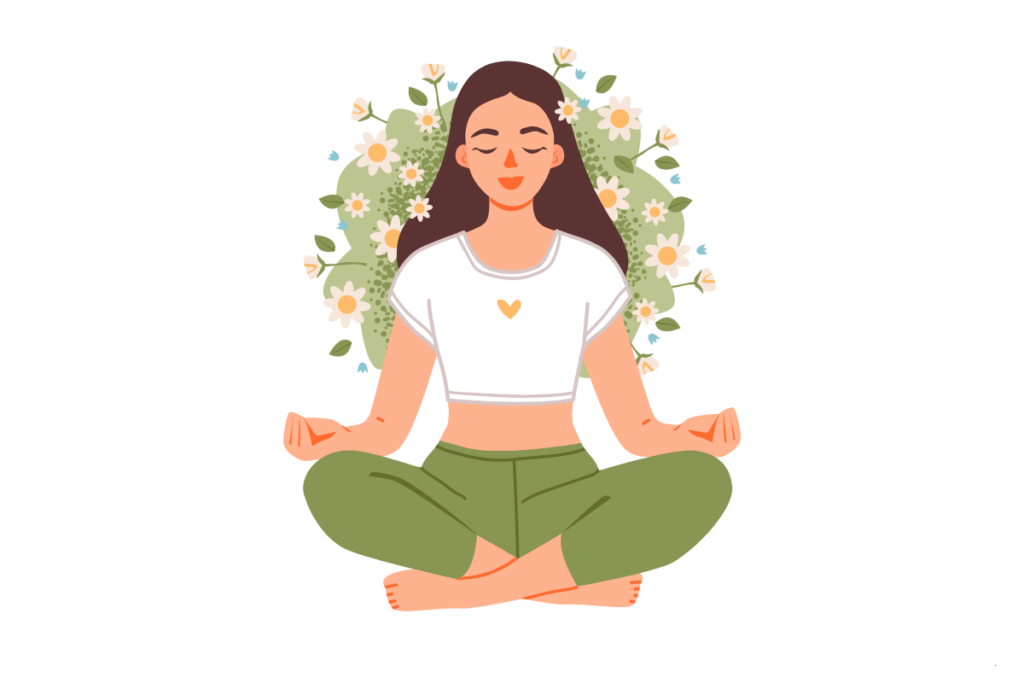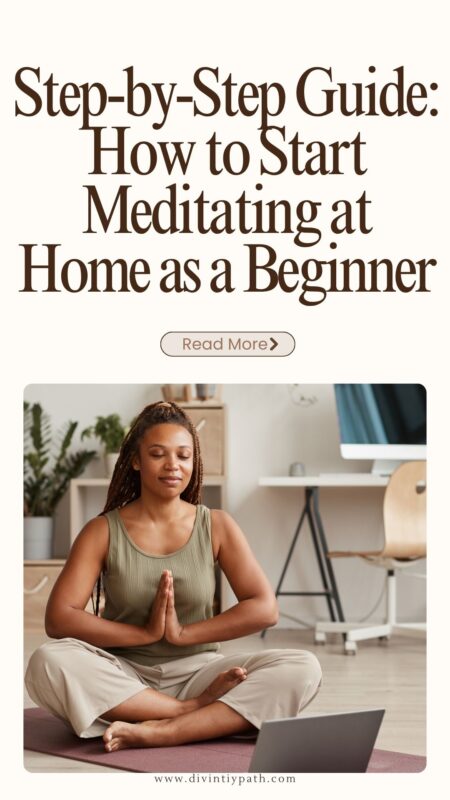Step-by-Step Guide: How to Start Meditating at Home as a Beginner
Have you ever wanted to start meditating at home but had no idea where to begin? Don’t worry – you’re not alone. Most beginners get caught up in questions like: “How should I sit? How long should I meditate? Am I even doing it right?” Good news: how to start meditating at home as a beginner is much easier than you think. You don’t need a special space, fancy cushions, or expensive courses – all you need is a few minutes and the desire to simply… start.
In this article, I’ll guide you step by step on how to start meditation at home, how to create a routine that truly works for you, and how to overcome the doubts that hold you back. Ready? Together, we’ll take the first simple steps toward peace and focus – right at home, at your own pace.
What is Meditation?
Definition and Purpose
Meditation is, simply put, a practice where we intentionally slow down the pace of our daily lives and dedicate a few moments solely to ourselves and our minds. You don’t need to “empty your mind” or try to be perfectly still – the goal is to observe what’s happening inside and around you without judgment. This could be noticing your breath, thoughts, feelings, or the sounds in the room. With regular meditation practice, we learn to calm restlessness, reduce stress, and improve focus, while also building a deeper connection with ourselves.
Different Types of Meditation
Meditation isn’t just one method – there are several types that differ in approach, but all provide similar benefits. For beginners, it’s good to know the three basics:
- Mindfulness Meditation – This is about being fully present in the moment. We observe thoughts, feelings, and surroundings without judgment or trying to change anything. It’s perfect for those who want to better understand their inner world and learn to be “here and now.”
- Breathing Meditation – One of the simplest methods for beginners. You focus on your breath – how you inhale and exhale. When thoughts wander, gently bring your focus back to the breath. This is a wonderful way to calm your mind quickly and relax, even if you only have five minutes.
- Guided Meditation – In this method, you follow instructions from a teacher or a recording that guides you through meditation. It’s excellent for beginners because it leads you step by step and helps you stay focused until you can practice independently.
Beyond these basics, there are other types, such as visualization, mantra meditation, or moving meditation (like yoga), but for starters, it’s best to focus on one or two techniques.
Common Misconceptions About Meditation
When we start thinking about meditation, doubts and misconceptions often appear. Many believe meditation isn’t for them because they “can’t stop thinking” or think they need special tools. Here’s the truth – it’s completely normal and much simpler than you might think.
- “I can’t stop thinking” – Totally normal! Thoughts will always come. Meditation isn’t a competition to empty your mind; it’s the practice of observing your thoughts and gently returning to your breath or focal point.
- “I need special equipment” – No! You don’t need fancy cushions, special lights, or expensive tools. All you need is a space to sit and a few minutes of your time.
- “Meditation takes too long” – Many think they must meditate for hours for it to work. The truth? Even five minutes a day can make a big difference if you’re consistent.
- “I’m too restless for meditation” – If you move quickly, have a restless mind, or are hyperactive, it’s not a barrier. Meditation teaches you to observe and guide restlessness, not prevent it.
- “Meditation is only for spiritual people” – Not true! Meditation isn’t a religion or spiritual practice. It’s a tool for anyone who wants to calm their mind, improve focus, and achieve emotional balance.
- “I must do it perfectly” – Many beginners think they must meditate without mistakes. Nothing can be “wrong.” If you are focused and observing your thoughts, you are already practicing meditation.
- “I won’t see results quickly” – Some give up because they don’t notice immediate changes. Results come gradually. After a few weeks, you’ll notice more calm, better sleep, and less stress if you persist.
- “Meditation is boring” – If it feels boring, it’s actually a sign your mind needs training. Even a few minutes of observing your breath or listening to a guided meditation can become relaxing and enjoyable.
Why You Should Meditate at Home
Meditating at home has many benefits that are often overlooked. The first and most obvious: complete freedom. You can choose your space, your time, and your rhythm. No distractions, no clock-watching, no comparing yourself to others – just you and your mind. This is what helps when learning how to start meditating at home as a beginner.
Second, at home, meditation can easily fit into your daily life. Five minutes after your morning coffee, ten minutes before bed, or during a break – you set the pace. Regular practice, even short, brings results: it reduces stress, improves focus, and even helps you sleep better.
Third, home is a safe and comfortable space. You don’t have to prove anything; you can try different techniques – mindfulness, breathing, or guided meditations – until you find what truly works for you. It’s at home that you learn to observe your thoughts, connect with yourself, and gradually build a lasting routine.
You might also love:
- 11 Natural Ways to Calm Stress at Home Without Extra Effort
- How to Embrace Aging as a Woman and Feel Radiantly Confident
- How to Stop Overthinking Before Sleeping and Fall Asleep Easier
How to Start Meditating at Home as a Beginner (Step-by-Step Guide)
Step 1: Choose a Calm and Comfortable Space
Start by finding a space where no one will disturb you. It’s important that you feel calm and comfortable there. It doesn’t need to be large or special – it could be:
- A bedroom (in a corner where no one enters)
- A balcony or terrace, if it’s quiet
- A living room (on a chair or mat)
- A yard, if you have a peaceful outdoor spot
Sit on a chair, cushion, or blanket – whatever feels comfortable. The key is to keep your back straight but relaxed, and feel stable. This is your “mini meditation corner,” a place you can always return to.
Step 2: Decide on the Length of Your Meditation
For beginners, it’s better to start slowly. Choose a duration you can comfortably manage without feeling pressured. Suggestions:
- Start with 2–5 minutes – enough to calm down and experience the practice.
- Once accustomed, gradually increase to 10–15 minutes.
- Use a timer or app so you don’t have to watch the clock.
You can also experiment with different lengths at different times of the day – morning, noon, or evening – to see what works best for you.
Step 3: Sit Comfortably
A correct but relaxed posture is key for effective meditation. Focus on your body first, without jumping to other techniques.
- Sit on a chair or cushion.
- Keep your back straight but relaxed – don’t tense your shoulders.
- Rest your hands on your knees or in your lap.
- If sitting on a chair, keep your feet firmly on the floor.
Experiment until you find a position that feels comfortable. Stability and relaxation are most important, so nothing distracts you from observing your breath.
Step 4: Focus on Your Breath
Now it’s time to direct your focus to one of the foundations of meditation – your breathing.
- Close your eyes or gaze softly at a point in front of you.
- Inhale slowly and deeply, then exhale.
- Notice how your chest rises and falls or how the air flows through your nose.
Tip: Don’t try to control your breath, just observe it. If thoughts wander, gently bring your attention back to your breath. You can also count your inhales and exhales or use a simple word like “peace” to stay focused.
Step 5: Observe Your Thoughts
It’s completely normal for your mind to wander during meditation – it happens to everyone. Your task isn’t to stop your thoughts, but to observe them. Imagine them as clouds slowly drifting by. Don’t judge them; just notice them and gently return your focus to your breath. If you feel frustrated, take a deep breath and say to yourself: “It’s okay for my thoughts to wander, I am returning to my breath.” This is completely normal and part of learning how to start meditation at home.
Keep exploring:
- 60 Solo Date Ideas for Men Ready to Enjoy Their Own Company
- 11 Calming Ways to Combat Holiday Stress and Actually Enjoy the Season
- Solo Date Ideas for Women Who Want to Fall in Love With Life Again
Step 6: Use a Simple Technique (Optional)
Once you’re comfortable observing your breath, you can try one of these simple techniques:
- Counting breaths: Inhale (1), exhale (2) up to 10, then start again. Helps maintain focus.
- Repeating a mantra: Silently repeat a word or phrase that calms you, e.g., “peace” or “I am relaxed.”
- Guided meditation: Use apps or free YouTube videos – great for beginners seeking structure.
Experiment and choose the method that works best for you. The main goal is to keep meditation simple and enjoyable.
Step 7: End Gently
When it’s time to finish, don’t rush to open your eyes or get up. Take a few more deep breaths, stretch lightly, and notice how you feel. Take a moment to acknowledge your progress – every attempt counts! Appreciate your effort, as recognizing your own progress is key to building the habit.
Step 8: Build a Consistent Routine
It’s best to incorporate meditation into your daily life:
- Choose the same time each day, e.g., morning or before bed.
- Start short and realistic – 2–5 minutes, then gradually extend.
- Track your progress in a journal or app – even noting how long you meditated helps build the habit.
Step 9: Be Patient and Kind to Yourself
Meditation is a skill that improves with regular practice. If you miss a day, don’t give up – continue the next day. Focus on progress, not perfection. Every minute you dedicate to yourself and your mind counts.
Frequently Asked Questions About How to Start Meditating at Home as a Beginner
Beginners often think they need to meditate for hours to see any effect. That’s not true. Start small – 2–5 minutes is more than enough to feel what meditation is about. Once you practice regularly, you can gradually increase the time to 10–15 minutes or more.
Tip: It’s better to meditate a little every day than to do one long session once a week. Consistency is what truly brings change.
Yes, absolutely! Especially if you meditate in the evening or are very tired, you might doze off. Your mind is relaxing, and that’s part of the process.
If you want to stay awake, try:
– Sitting on a chair (instead of lying down)
– Keeping your back straight but relaxed
– Meditating in the morning or at noon when you are more alert
Even if you fall asleep, don’t worry – you’re still giving your body and mind a chance to relax.
The main purposes of meditation are:
– To calm the mind
– To increase awareness and presence
– To reduce stress and tension
– To improve concentration
For beginners, the goal is to notice your thoughts and feelings, not to “fix” them immediately. Meditation is the practice of returning to the present moment and connecting more deeply with yourself.
Yes, you can! People often think meditation can only be done sitting, but lying down is also an option. The key is to feel comfortable and able to stay attentive.
Tip: If you fall asleep easily while lying down, try:
– Slightly elevating your head with a pillow
– Using a shorter meditation session
– Meditating in the morning or at noon when you are more alert
The 5 R’s are simple rules to help you stay in meditation when your mind wanders:
Recognize – Notice that your attention has drifted from your breath or focus.
Release – Gently let go of the thought without judgment.
Relax – Release tension in your body and mind, don’t force anything.
Return – Bring your focus back to your breath or meditation technique.
Repeat – Repeat the process as many times as needed.
This method is excellent for beginners because it helps you navigate your thoughts gently, without frustration or feeling like you’re doing it “wrong.”
A question almost every beginner asks: “Am I even meditating correctly?” The answer is simple – yes, you are! Meditation isn’t a competition and has no strict rules. If you sit, breathe, and observe your thoughts, you are doing it correctly.
It’s important not to judge yourself if your mind wanders or you feel restless. For beginners, the goal is to notice your thoughts and feelings, not control th
Short answer: you can’t. This is the most common misconception! Thoughts will come and go – this is completely normal.
Instead of trying to “turn off” your thoughts, observe them like clouds in the sky and gently return your focus to your breath or point of attention. Techniques like counting your breaths or using a mantra can help guide your mind.
It depends on you! Music or natural sounds can help create a relaxing atmosphere, especially if you are just starting. On the other hand, some people find music distracting when trying to focus.
Suggestion: Try meditating both with and without music and notice what works best for you. The key is to feel comfortable and focused, regardless of the sounds around you.
There’s no strict rule. Some people prefer meditating on an empty stomach because they feel light, while others focus better after a small meal. It’s important to experiment and find what works best for you.











